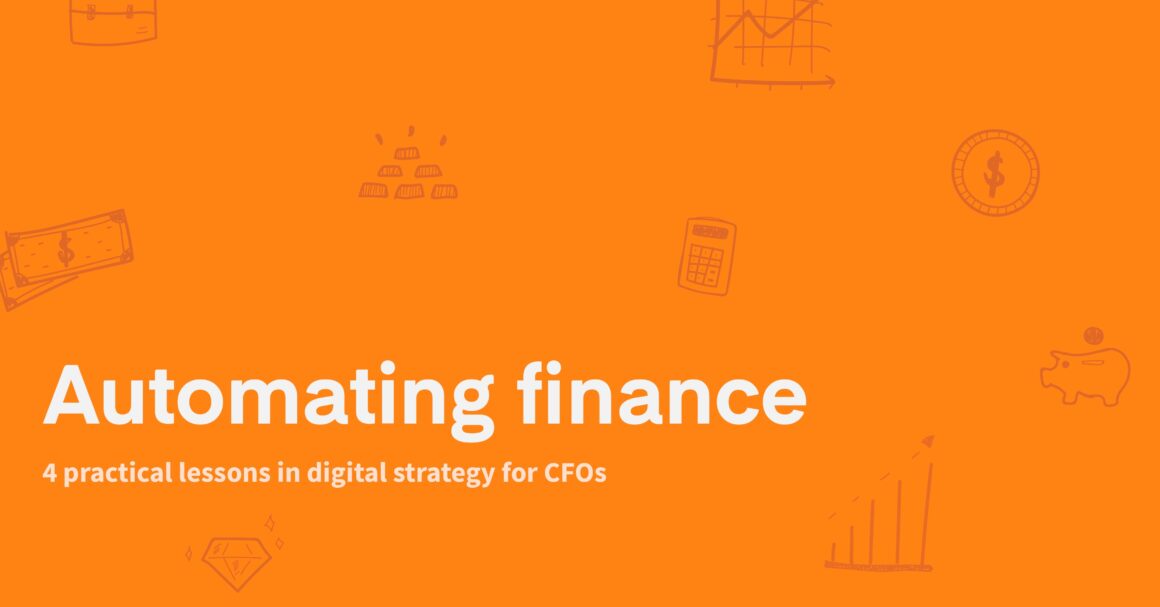
How can you turn your big finance transformation ideas and objectives into tangible solutions? What is your organization doing to implement finance automation across the entire organization? Successfully pursuing an automation strategy for your finance department may seem hard—but with the right foundation—it’s more than possible.
Digital transformation—it’s a popular term that you’ve likely heard by now. But a successful digitization strategy is impossible without maintaining complete control over the data that your everyday business functions rely on.
And while digitizing core processes like sales, expenses, and other accounts payable and receivable tasks may seem complex—that isn’t always the case.
Still, your company needs to understand how to approach this process if you want to avoid hiring an army of consultants or vastly increasing the size of your IT team. Just knowing that insight alone means you’re already more prepared than most CFOs.
The building blocks of finance transformation
A successful finance transformation strategy needs the right building blocks, to ensure efficient automation and control.
The first step requires you to focus on digitization.
This means finance teams need to exercise control over the transactional information they are looking to change. CFO’s must explore these processes, and that means asking the following questions:
- How is finance data created?
- How are transactions processed?
- What are the organization’s objectives?
The building blocks are your data. Better quality data will always lead to better quality outcomes. This simple point is true all the way down to your bottom-line, and a well-designed automation system will result in increased efficiency and insightful analytics.
It may even lead to the creation of new business models, with the final outcome being a complete digital transformation.
Step 1: Assess your company’s automation potential
New technologies allow businesses to remain competitive as they adapt to changing business climates. But digital transformation solutions aren’t one-size-fits-all. A successful transformation requires a thorough understanding of your data and how you plan to automate it. CFO’s are ideal candidates to kickstart a digital transformation initiative because they understand key transactional data.
So, how does an organization approach automation? The first step is to define your company’s automation potential.
- Identify what areas you can automate. What will your company achieve with automation? Define what your automation potential looks like by establishing the ratio between analog and digital input data. Consider things such as manual account entries, E-invoices vs. paper invoices vs. PDF invoices, and more.
- How many paper or PDF invoices are you using? Anything you can convert into a digital process is a win that reduces your risk, increases visibility, and an essential step to creating an end-to-end process automation system.
- How do you distribute sales invoices? Consider what formats you use. Determine the ratio between manual and online orders.
Step 2: Improve your digital inputs
A successful digital transformation requires teamwork. You must also rely on your suppliers to support these changes. However, the majority of the risk is on your supplier as they could lose you as a customer.
There are two approaches you can take. Either you incentivize or force your suppliers to adopt e-invoices in support of your push to enhance the quality of the data you use in your end-to-end transactional systems.
Regardless of what system you use, you should take the time to:
- Identify the various data formats you rely on right now.
- Define what information is crucial to your company for both your procurement and accounts payable processes.
- Communicate with your suppliers to develop a plan to encourage them to adopt e-invoices.
- Assess, update, or replace software systems to complement your new digital data initiatives.
Step 3: The right approach to financial automation
High-quality data is the backbone of any automation effort. E-invoices are the fastest way to improve data quality for most companies.
Both AI and RPA technologies are effective when it comes to repetitive and highly structured tasks—but they struggle with deviations. These systems struggle to cope with change, and no amount of fine-tuning will change that.
Your pathway to financial automation starts with thinking about the specific areas you can improve—immediately. Start by assessing your current systems and creating simple charts showing how the data is being processed. This may include:
- Mapping how transactional data is processed across your organization, from input to output data.
- Creating detailed charts of your workflows. These charts should be as visual as possible to illustrate potential hurdles and opportunities for optimization.
- Listing systems and software you currently use. Every system involved in a process increases your risk of damaging your data. Think about what systems you are using and the total costs.
- Framing your challenges. Create a shortlist that highlights organizational complexities, risks, costs, and bottlenecks.
Step 4: Know Your Suppliers
The final step involves organizing your data. This includes cleaning up data, keeping your supplier registry organized, and other housekeeping duties related to your data. You should aim to:
- Analyze how you manage your supplier ledger. Look at everything, including roles, processes, software, and other key touchpoints.
- Define what an “active” supplier is. Establish what criteria a supplier must meet to be deemed an “active” supplier.
- Determine when a supplier’s status should be changed. Whatever you do decide, ensure that it aligns with your other processes and tools.
- Assess any financial risks that are related to your suppliers. Assess credit ratings, insolvency, due dates, transactional frequency, and more.

Are you interested in learning more? Qvalia has created a new ebook that’s designed to guide finance teams through their digital transformation.